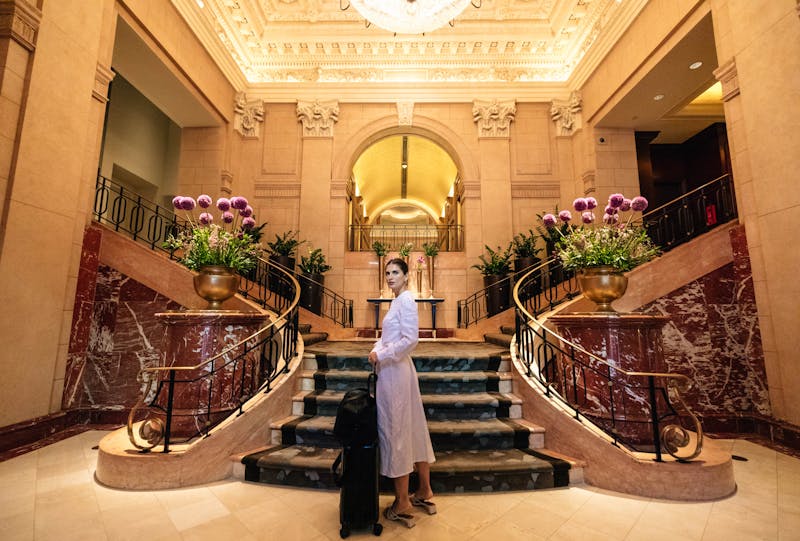Social media is an essential element of any hotel marketer’s playbook, and creation of a strategic social plan has become more critical than ever in order to drive awareness and consideration and stay ahead of competition. Evolving consumer behaviors are showcasing a rise in social usage, including the evolution of ecommerce; social shopping has become prominent, and platforms have become the new go-to marketplace. This is an important note for travel brands, as many platforms have developed capabilities that allow consumers to book reservations directly through social apps – a trend that will continue to gain popularity.
As the travel industry continues to move into recovery, hotel marketers can optimize their social presence now in order to create more opportunity to capture future bookings. However, determining which social platforms are ideally suited to meet specific business goals can be a daunting task; determining a social media mix takes careful consideration and an understanding of each platform’s demographics, reach and functionality.
There are currently hundreds of social platforms available globally, with new and emerging features popping up to meet the growing demand of online audiences. So how do you strategize? Within this article we’ll provide a top-level view of best practices for building a social media platform strategy in order to maximize your marketing potential.
This takes a bit of planning, followed by strong execution. With the right social strategy, marketers can achieve effective content placement, ROI-rich advertising spend, and increased opportunities to drive demand. Here’s how to get started.
Defining your hotel’s platform strategy
Defining a clear platform strategy is often overlooked but is a critical component for success. A smart approach can ensure that marketing dollars are utilized effectively and provide a return on investment, especially when adding a new platform to your marketing plan. It is imperative to craft a strategy and test audience sentiment to inform future marketing spend.
A few key items to consider as you begin your planning:
1. Who is your ideal audience? Understanding the specific demographics you would like to reach in order to achieve your overarching marketing goals is important. Since social is largely pay-to-play, narrowing your target can assist with maximizing marketing dollars, by reaching the consumers that will be the most driven to book.
2. Where are target audiences spending their time online? Once you have determined your target consumers, understanding where they are spending their time online and how they are consuming social content is critical. As an example, if your key goal is to target business travelers, LinkedIn provides an incredible opportunity for awareness among Millennials and Gen Xers, who are the most inclined to return to business travel first following recovery.
3. How are audiences using each platform? Understanding the behaviors across social platforms is also important. LinkedIn has become the space to not only seek employment opportunities and grow professional connections, but to also read thought leadership articles from authorities within an industry – creating a fantastic ground for relaying company culture and attracting qualified talent. TikTok, along with being a platform for quick entertainment and fun, is now becoming an educational area for Gen Z's to explore travel destinations virtually. Meanwhile Pinterest is the place for travelers to plan future trips and gain inspiration through imagery, creating a valuable data mine for brands to tap into for trendspotting.
4.Does the platform offer eCommerce opportunities? The ability to provide direct links or shoppable content on a platform can equate to a seamless booking opportunity for consumers, offering travel marketers increased benefit. Additionally, several platforms are now offering enhanced monetization structures for paid influencers – which can be a compelling reason to prioritize your brand’s presence.
5. Do the advertising options fit your budget? Most of the major social platforms are consistently evolving their advertising features in order to allow businesses both large and small an opportunity to play in the paid space. However, it’s important to understand the return on investment that specific ad formats can yield; the creation of a branded filter is a much larger investment than a simple post boost but can achieve much different results. Integrating a strategic paid strategy to complement your social presence is a valuable way to ensure your approach is the right one for your goals.
6. How large should social presence be?
Creating a comprehensive social strategy can help to reach consumers at more than one point along their online journey, which can produce heightened awareness and consideration. However, being present just to be present can create an unwanted effect; consumers expect to see authentic, consistent engagement from brands. If your budget does not allow for adequate content creation, advertising, and community management efforts, it may be best to stick with three primary platforms as opposed to presence across six.
Building a Backbone
At BCV, we consider three giants within the social space as forming the core of any strategic mix: Facebook, Instagram, and Twitter. Together these platforms create the perfect synergy for a travel marketer, as they offer the largest global mindshare – meaning, your target guests are likely using one if not all of them every day. Let’s break them down a bit more.
- Facebook and Instagram offer the highest potential to garner reach and engagement based on the sheer size of their global audience presence. Specifically for the travel industry, these two platforms support one another: Instagram provides visual inspiration that drives consideration for travelers, who then turn to Facebook as a home base for information. This often creates a traveler journey path of dreaming and discovery driven by Instagram leading to planning and purchase action driven by Facebook.
- Twitter serves a different primary purpose, as it’s less about visual interest and more about real-time engagement. This platform is where social users often go to ask questions and share experiences through immediate conversation, which has become essential for building trust and advocacy among consumers.Twitter can also be a vital tool for mitigating negative sentiment. Many travelers turn to the platform to share complaints, offering hotels an incredible opportunity to turn bad experiences into positive ones through social interaction. Overlooking this platform could equate to these opportunities being missed or worse, becoming escalated by lack of response by the brand.
Once you have established presence on these priority platforms, additional social success can be achieved through the inclusion of supplemental platforms chosen for your specific goals.
Beyond the Big Three
Creating a comprehensive social strategy that goes beyond Facebook, Instagram, and Twitter can be key for driving impactful results and intersecting consumer consideration journeys to drive bookings.
Below is a high-level breakdown of six additional platforms that can work hard to support a larger social strategy. An important note: when stepping into platforms that are new to your brand, it can be imperative to test audience sentiment first before allocating resources to build an owned presence. This is especially true for emerging platforms that are rapidly evolving, such as TikTok; at BCV, we typically recommend creating paid partnership or advertising opportunities to test audience reactions towards brand messaging in order to ultimately determine future marketing spend.
- LinkedIn is largely a networking and recruitment engine but is quickly becoming a source of news and education for many consumers. The platform currently boasts nearly 740 million users worldwide, creating an ample space to reach industry professionals who typically have higher disposal incomes than other platform audiences for larger purchases such as travel. Hotel marketers have the opportunity to build authority, brand reputation, and display thought leadership among a valuable demographic across the platform – many of whom travel for work.
- YouTube is the world’s second most popular search engine after Google and has quickly skyrocketed into the most-used social platform globally, recently surpassing Facebook. It’s a valuable tool for brands to seed messaging across audiences as they immerse themselves in an ongoing feed of video content providing entertainment, education, inspiration, and news. As video consumption continues to rise in general, brands that create a presence on YouTube through strategic ad placements will be able to drive valuable reach across key audiences.
- Pinterest is a platform for visual discovery, trendspotting, and planning – creating a perfect fit for travel and hospitality. The strong focus on visual content attracts consumers who are actively seeking inspiration for future travel. Because Pinners typically seek and save content three months ahead of an event, such as hosting a party or taking a trip, Pinterest is incredibly valuable for identifying trends to inform future marketing content planning. Bonus: Pinterest has continued to roll out sophisticated marketing features beneficial for travel brands, including their eCommerce capabilities, Creator Studio, Premiere video ad product, and Trends and Conversion Insights.
- TikTok is all about fun, engaging, and immersive short-form video content; popular content themes include dance challenges, remixes, hashtag challenges, behind-the-scenes peeks, and humor/memes. However, there’s also a more serious side, with topics such as FinTok leveling up the conversations. The primary user age for this platform is the younger Generation Z, which can be a critical audience for brands as this audience holds influential power within their households for purchasing decisions, such as family vacation destinations.
- Snapchat is the original platform for real-time, disappearing content. It’s designed for communicating as we would in person, without the focus on saved content or aesthetically arranged feeds. The platform has continued to evolve its capabilities for brand marketing and offers strategic placements according to user data; as an example, specific ads can be served to audiences who are within a few blocks from a specific location, like a restaurant recommendation received during a trip. Another area to watch: within countries that are currently banning TikTok, such as India, audiences are vastly turning to Snapchat – creating mega opportunity for reach.
- Clubhouse is an audio-based platform that allows users to listen to and participate in conversations across various topics. Currently in beta mode and invitation only, Clubhouse features chats that are often moderated by celebrities and thought leaders, designed to educate and inform global audiences. As with any emerging platform, we are closely monitoring how travel brands could utilize this space, and what competitive platforms are developing in response to the growing popularity. Watch-out: with the current lack of advertising options, Clubhouse’s limited reach could be a major detractor for brand play.
Bringing it all together
Understanding how to navigate the social space can be challenging; if you’re wondering how to effectively choose your own strategic path, you’re not alone. Social media is a far-reaching landscape that is constantly evolving, and it’s not always obvious how to approach each platform and create a seamless, hard-working plan.
The most important actions are to dedicate the time necessary to build a social strategy, followed by consistent testing and optimization to find the perfect mix. Your brand’s social media mix should build awareness and directly impact your larger marketing funnel. From awareness to purchase, a multi-dimensional social presence will intersect consumer journeys multiple times to drive consideration and incite action, ultimately leading to increased revenue.
And as always, BCV is here to help! Our team of savvy social media experts can craft strategic support in order to ensure that your marketing budget is applied wisely. We love what we do and love to see increased revenue as a result of our work.
If you’d like to receive further information about BCV’s approach to social or to begin building a customized strategy to produce efficient ROI, BCV can help.
.jpg?ixlib=gatsbyFP&auto=compress%2Cformat&fit=max&w=800&h=800)

